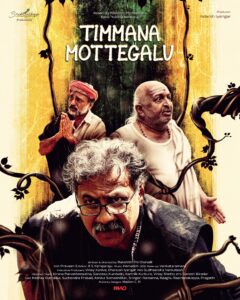
Timmana Mottegalu Review: A Slow-Burning Fable of Forest, Faith, and Fate Rooted in Nature and Culture

Timmana Mottegalu review: A poetic Kannada film blending folklore and ecological dilemmas. Explore the clash of science, spirituality, and survival in Malnad’s lush forests with compelling performances and breathtaking visuals.
Blog Post:
Timmana Mottegalu Review: A Thoughtful Tale of Nature, Faith, and Human Struggle
Director Rakshith Thirthahalli adapts his own short story Kaddina Nentaru into a meditative, slow-burning film set in the rain-drenched forests of Malnad. Timmana Mottegalu is more than just a story—it’s a poetic exploration of the tension between tradition and modernity, survival and conscience, faith and science.
Plot Overview: Forest, Faith, and the Fight to Survive
The film centers around Timma (Keshav Guttalike), a modest forest dweller whose house is destroyed in a storm. Desperate to rebuild, Timma turns to Venkataiah (Sringeri Ramanna), a spiritual guardian of the forest, who warns him against disturbing nature’s sacred balance.
When a team of researchers led by Vijay Kumar (Suchendra Prasad) arrives to study the elusive king cobra, Timma is caught in a dilemma—help the outsiders in exchange for money or heed the spiritual warnings of his community. The clash between the rational, scientific world and the spiritual, ecological reverence forms the heart of the story.
Themes: Nature, Survival, and the Sacred
Timmana Mottegalu carefully navigates the complex relationship humans share with the environment. It questions:
-
How do we balance survival needs with respect for nature?
-
What price do we pay when ancient beliefs confront modern ambition?
-
Can science and spirituality coexist without conflict?
The film’s narrative also subtly touches on social inequality, showing how even children absorb the class divides present in their society—highlighting how exploitation and ownership are ingrained from an early age.
Performances: Grounded and Genuine
Keshav Guttalike’s portrayal of Timma is quiet yet powerful, perfectly capturing a man torn between tradition and necessity. The child actors, especially in their candid conversations about land and ownership, add emotional depth and social commentary.
Suchendra Prasad as the determined researcher and Sringeri Ramanna as the spiritual elder round out a cast that embodies the film’s central tensions.
Cinematography & Music: A Love Letter to Malnad
Praveen’s cinematography paints the Western Ghats in rich, evocative strokes—misty forests, rain-soaked leaves, and deep shadows become characters themselves. Every frame is a visual poem, reflecting the film’s deep reverence for its setting.
Hemanth Jois’s musical score is ambient and lyrical, perfectly echoing the mood of the forest and the emotional undercurrents of the story without overwhelming the narrative.
Narrative Style: A Slow-Burning Folktale
The film unfolds with the patience of a folktale, blending realism with moments of surrealism—especially in dream sequences where Timma confronts his guilt and the forest’s mystical forces. This measured pace invites viewers to immerse themselves fully and reflect on the film’s moral questions.
Final Thoughts: A Reflective, Unsettling Journey
Timmana Mottegalu is neither a conventional drama nor a pure docu-film; it sits in between, delivering an understated but powerful message about coexistence and conscience. It resists offering easy answers, instead prompting us to consider what we protect—and what we lose—when survival, faith, and progress collide.

Leave a Reply